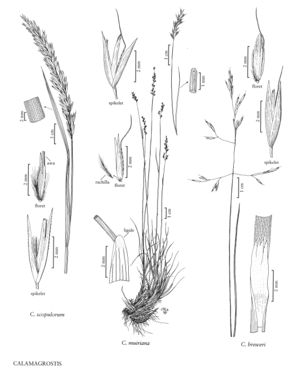Difference between revisions of "Calamagrostis muiriana"
FNA>Volume Importer |
FNA>Volume Importer |
||
| Line 17: | Line 17: | ||
-->{{Treatment/Body | -->{{Treatment/Body | ||
|distribution=Calif. | |distribution=Calif. | ||
| − | |discussion=<p>Calamagrostis muiriana grows in moist to dry, subalpine and alpine floodplain meadows, lake margins, and stream banks, at 2400-3900 m, in the Sierra Nevadas south of Sonora Pass in central California. It differs from C. bolanderi (p. 719) in having basally concentrated leaves.</p> | + | |discussion=<p><i>Calamagrostis muiriana</i> grows in moist to dry, subalpine and alpine floodplain meadows, lake margins, and stream banks, at 2400-3900 m, in the Sierra Nevadas south of Sonora Pass in central California. It differs from <i>C. bolanderi</i> (p. 719) in having basally concentrated leaves.</p> |
|tables= | |tables= | ||
|references= | |references= | ||
| Line 26: | Line 26: | ||
-->{{#Taxon: | -->{{#Taxon: | ||
name=Calamagrostis muiriana | name=Calamagrostis muiriana | ||
| − | |||
|authority=B.L. Wilson & Sami Gray | |authority=B.L. Wilson & Sami Gray | ||
|rank=species | |rank=species | ||
| Line 33: | Line 32: | ||
|basionyms= | |basionyms= | ||
|family=Poaceae | |family=Poaceae | ||
| − | |illustrator=Cindy Roché | + | |illustrator=Cindy Roché;Hana Pazdírková |
| + | |illustration copyright=Utah State University | ||
|distribution=Calif. | |distribution=Calif. | ||
|reference=None | |reference=None | ||
| Line 39: | Line 39: | ||
|publication year= | |publication year= | ||
|special status= | |special status= | ||
| − | |source xml=https:// | + | |source xml=https://jpend@bitbucket.org/aafc-mbb/fna-data-curation.git/src/f50eec43f223ca0e34566be0b046453a0960e173/coarse_grained_fna_xml/V24/V24_1012.xml |
|subfamily=Poaceae subfam. Pooideae | |subfamily=Poaceae subfam. Pooideae | ||
|tribe=Poaceae tribe Poeae | |tribe=Poaceae tribe Poeae | ||
Revision as of 20:17, 16 December 2019
Plants sometimes with sterile culms; densely cespitose, often with rhizomes 1-3 cm long, 1-2 mm thick. Culms (10)12-35 cm, unbranched, smooth beneath the panicles; nodes 1-3. Leaves basally concentrated; sheaths and collars smooth or scabrous; ligules 1-2.5 mm, obtuse, entire to lacerate; blades (1)4-12 cm long, 0.2-0.4 mm in diameter, involute, abaxial surfaces scabrous, adaxial surfaces sparsely hairy. Panicles (1.5)1.9-5.7(7.5) cm long, 0.4-3 cm wide, contracted to open, usually dark purple, rarely straw-colored; branches (0.8)1.1-2(3.5) cm, smooth, spikelets usually confined to the ends of the branches. Spikelets (3)3.5-4.5(5) mm; rachilla prolongations about 2 mm, hairs 0.5-1 mm. Glumes rounded, midvein smooth or slightly scabrous, lateral veins obscure, apices acute to acuminate, rarely awn-tipped; callus hairs (0.2)0.3-0.6 mm, 0.1-0.2 times as long as the lemmas, sparse; lemmas (2.5)3-4 mm, 0.5-1 mm shorter than the glumes; awns 3.5-6 mm, attached to the lower 1/3 of the lemmas, exserted, bent, purple; anthers 0.9-2.5 mm. 2n = 28.
Discussion
Calamagrostis muiriana grows in moist to dry, subalpine and alpine floodplain meadows, lake margins, and stream banks, at 2400-3900 m, in the Sierra Nevadas south of Sonora Pass in central California. It differs from C. bolanderi (p. 719) in having basally concentrated leaves.
Selected References
None.
